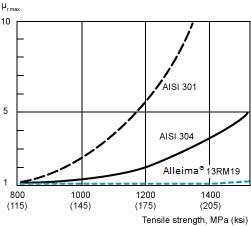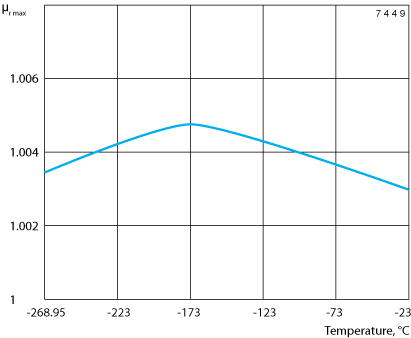Alleima® 13RM19 is a stainless spring steel combining high mechanical strength with a non-magnetic structure. This combination of properties has previously been found mainly in expensive Co-Ni-base or Cu-Be alloys. Corrosion resistance is comparable to ASTM 301.
Alleima® 13RM19 also possesses good fatigue properties and excellent ductility, which makes it a most suitable choice for springs and other high-strength applications where ferromagnetic materials cannot be used.
Alleima® 13RM19 main characteristics:
- Non-magnetic structure in all conditions
- High mechanical strength in the cold rolled condition. Strength can be further increased by tempering, without any effect on the non-magnetic structure.
- High elastic limit and energy storing capacity in the cold rolled and tempered condition which is important for spring applications.
Service temperature: up to 250°C (480°F)
Standards
- EN Number: 1.4369
- EN Name: X 11 CrNiMnN 19-8-6
Chemical composition (nominal)
| C | Si | Mn | P | S | Cr | Ni |
|---|---|---|---|---|---|---|
| 0.11 | 0.8 | 6.0 | ≤0.030 | ≤0.015 | 18.5 | 7 |
Others: N=0.25
Applications
The combination of high strength and non-magnetic behavior makes Alleima® 13RM19 very suitable for springs and other high strength components in the electronic and computer industries.
Typical products where Alleima® 13RM19 can be used to advantage are printers, springs in generators, magnetic instrument housings, components in measuring instruments, zipper parts and other components that require non-magnetic properties. The grade is also used in surgical tools and other equipment for open architecture magnets in which surgery is performed simultaneously with magnetic resonance imaging.
The high strength also makes Alleima® 13RM19 suitable as a cable armoring material for high voltage cables, where transmission losses must be kept low.
Corrosion resistance
Alleima® 13RM19 has a corrosion resistance comparable to that of ASTM 301/304. The high nitrogen content is known to be beneficial for resistance to pitting and crevice corrosion. However, all austenitic steels of this type are susceptible to stress corrosion cracking (SCC) when in contact with chloride solutions at elevated temperatures.
Bending
The values given below have been obtained by bending according to Swedish standard SS 11 26 26 method 3 (in a 90° V-block with a 25 mm die opening, a sample of 35 mm width, turned so that the burrs of the blanked edges face into the bend). They can be used as guidance for the smallest recommended bending radius.
| Nominal tensile strength, Rm | Thickness (t) | Min. bending radius*) | |
|---|---|---|---|
| MPa | mm | ⊥ | // |
| 1300 | 0.25 | 0.5 t | t |
| 1300 | 0.50 | 0.5 t | 4 t |
| 1500 | 0.25 | 1.5 t | 3.5 t |
| 1500 | 0.50 | 1.5 t | 6 t |
⊥ Bend transverse to the rolling direction
// Bend parallel to the rolling direction
Forms of supply
Strip steel can be supplied in coils, bundles, on plastic spools or in lengths. The edges can be either slit, deburred or smoothly rounded.
Conditions and dimensions
Alleima® 13RM19 is supplied in the cold rolled or solution annealed (bright annealed or annealed
and pickled) condition.
| Condition | Tensile strength, Rm | Thickness | ||
|---|---|---|---|---|
| MPa | ksi | mm | in. | |
| Annealed | 850 | 123 | 0.03-4 | 0.0012-0.16 |
| Cold rolled | 1100 | 160 | 0.025-3.2 | 0.001-0.13 |
| Cold rolled | 1300 | 189 | 0.02-2.8 | 0.0008-0.11 |
| Cold rolled | 1500 | 218 | 0.015-1.9 | 0.0006-0.075 |
| Cold rolled | 1600 | 232 | 0.015-0.9 | 0.0006-0.035 |
Widths: 2-345 mm (0.08 - 13.6 in.)
Tolerances
The thickness and width tolerances are +/- tolerances to the nominal size. The normal tolerance classes for most of our strip products are T2 and B1. Tighter tolerances as well as other tolerance limits can be offered upon request.
Heat treatment
The strength of cold rolled steel can be increased by a tempering operation at 480°C (896°F) for 2 hours. For cold rolled Alleima® 13RM19 with a tensile strength above about 1400 MPa, an increase in tensile strength of about 100-200 MPa (14.5-29 ksi) can be expected. Further information on the nominal tempering effect can be seen under the 'Mechanical properties' section. This heat treatment is also beneficial for relaxation and fatigue resistance.
Tempering is normally carried out by the customer after forming. To avoid discoloration, parts should be carefully cleaned before heat treatment.
Tempering in open air furnaces gives a harmless brownish oxide on the surface.
Mechanical properties
Static strength
| Condition1) | Tensile strength, Rm | Proof strength, Rp0,2a) | Elongation, A11,3 | ||
|---|---|---|---|---|---|
| MPa | ksi | MPa | ksi | % | |
| A | 850 | 123 | 470 | 68 | 45 |
| C | 1100 | 160 | 975 | 142 | 12 |
| CT | 1130 | 164 | 1020 | 148 | 11 |
| C | 1300 | 189 | 1150 | 167 | 10 |
| CT | 1350 | 196 | 1220 | 177 | 8 |
| C | 1500 | 218 | 1350 | 196 | 3 |
| CT | 1650 | 239 | 1500 | 218 | 2 |
| C | 1600 | 232 | 1440 | 209 | 2 |
| CT | 1800 | 261 | 1630 | 237 | 1 |
1) A = Annealed, C = Cold rolled, CT = Cold rolled and tempered, 480°C (896°F)/2 h.
See further under section 'Heat treatment'.
a) Rp0.2corresponds to 0.2% offset yield strength.
1 MPa = 1 N/mm2
Fatigue strength
Nominal values at 20°C (68°F) in a normal dry atmosphere. The fatigue limit is defined as the stress at which 50% of the specimens withstand a minimum of 2 million load cycles.
Reversed bending stress
Average stress = 0
Bending transversal to rolling direction.

Comparison made for different thicknesses and tensile strength levels.
| Tensile strength, Rm | Thickness | Fatigue limit | |||
|---|---|---|---|---|---|
| MPa | ksi | mm | in. | MPa | ksi |
| 1600 | 232 | 0.40 | 0.016 | ± 605 | ±88 |
| 1800 | 261 | 0.20 | 0.008 | ± 680 | ±99 |
| 1800 | 261 | 0.40 | 0.016 | ± 635 | ±92 |
Fluctuating tensile stress
Minimum stress = 0
Specimens parallel to rolling direction.

Comparison made for different thicknesses and tensile strength levels.
| Tensile strength, Rm | Thickness | Fatigue limit | |||
|---|---|---|---|---|---|
| MPa | ksi | mm | in. | MPa | ksi |
| 1600 | 232 | 0.40 | 0.016 | 500 ± 500 | 73 ± 73 |
| 1800 | 261 | 0.40 | 0.016 | 535 ± 535 | 78 ± 78 |
Physical properties
The physical properties of a steel relate to a number of factors, including alloying elements, heat treatment and manufacturing route, but the following data can generally be used for rough calculations. These values refer to cold rolled material, at a temperature of 20oC(68oF) unless otherwise stated.
Density: 7.9 g/cm3 (0.29 lb/in.3)
Resistivity: 0.7 μΩm (27.6 μΩin.)
Modulus of elasticity: 190 000 MPa (27600 ksi)
| Temperature, °C | per °C | Temperature, °F | per °F |
|---|---|---|---|
| 30 - 100 | 16.5 | 85 - 200 | 9 |
| 30 - 200 | 17 | 85 - 400 | 9.5 |
| 30 - 300 | 18 | 85 - 550 | 10 |
| Temperature, °C | W/m °C | Temperature, °F | Btu/ft h °F |
|---|---|---|---|
| 20 | 15 | 68 | 8.5 |
| 100 | 16 | 200 | 9 |
| 300 | 19 | 600 | 11 |
Magnetic properties
From a magnetic point of view, materials can be divided into three groups, para-, dia- and ferromagnetic materials. In many practical cases, para- and diamagnetic materials will, however, interact strongly with the magnetic fields. In some cases, the ferromagnetic properties are desired, while in other situations no interaction with a magnetic field can be accepted.
The magnetic properties of a material are expressed as the magnetic susceptibility, c, or often as the magnetic permeability m = 1 + c. By definition, the magnetic susceptibility is placed at 0 for vacuums, from which it follows that m0=1. The magnetic permeability for a certain material is expressed as mr , which is its relative permeability versus vacuum. Further, as mr may vary with the magnetic field strength, the maximum value of mr max is often given as a representative value of the material.
Most types of high strength steel are ferromagnetic in spring hard conditions. The spring properties are achieved by hardening, e.g. carbon and chromium steels, or by cold rolling e.g. ASTM 301 (EN 1.4310). The origin of the properties is the martensitic structure. Higher alloyed steels e.g. ASTM 316, besides being more expensive, suffer from difficulties in reaching a high strength by cold working. If high strength is needed, together with a non-magnetic (para-magnetic) material, the option has traditionally been expensive Copper-Beryllium or Cobalt base alloys.
Alleima® 13RM19 is alloyed in such a way that the structure is very stable against a martensitic transformation but still allows a strong work hardening effect at deformation. Therefore, it is possible to obtain mechanical properties similar to ASTM 301, but maintain a non-magnetic structure. The low permeability is not influenced by a tempering operation. Alleima® 13RM19 also remains completely non-magnetic down to extremely low temperatures.
The following diagram shows typical values for the maximum relative magnetic permeability for Alleima® 13RM19, compared to ASTM 301 and 304.

| Condition | Tensile strength, Rm | Maximum µr max | |
|---|---|---|---|
| MPa | ksi | ||
| A | 850 | 123 | 1.003 |
| C | 1300 | 189 | 1.005 |
| CT | 1350 | 196 | 1.005 |
| C | 1600 | 232 | 1.03 |
| CT | 1800 | 261 | 1.03 |
Alleima® 13RM19 remains non-magnetic down to very low temperatures. The diagram below shows the magnetic permeability down to 4.2 K (-268.95°C) for material in the annealed condition.

Welding
Alleima® 13RM19, like most austenitic stainless steels, has good weldability. Welding, however, introduces excess heat into the material closest to the weld that breaks down the structure formed by cold working. As a consequence, this will decrease the mechanical properties of the welded area. The lowest practical heat input, <1,0 kJ/mm, and interpass temperature for multipass welding, <100°C (210oF), is recommended.
In most cases, the TIG (GTAW) method is preferable. It can be used either autogenously (without filler metal) or with filler metal. In both cases, pure argon (99,99%) should be used as the shielding gas. If a low loss of nitrogen is essential, Argon with 1 - 2% Nitrogen can be used instead.
When filler metal is used, the recommendation is to do it according to standard ISO 14343-A: 19 9 L; AWS A5.9/ASME SFA-5.9: ER308L; W.Nr.: 1.4316 and ISO 14343: 19 9 L Si; AWS A5.9/ASME SFA-5.9: ER308LSi; W.Nr.: 1.4316.
Due to the high carbon content of Alleima® 13RM19, there is also a risk of carbide precipitation at the grain boundaries of the material in the heat affected zone (HAZ), which may decrease the corrosion resistance of the material in certain environments
Disclaimer: Recommendations are for guidance only, and the suitability of a material for a specific application can be confirmed only when we know the actual service conditions. Continuous development may necessitate changes in technical data without notice. This datasheet is only valid for Alleima materials.